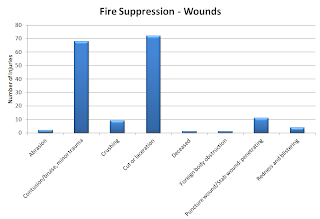A wound, as defined by Webster’s New World Stedman’s Concise Medical Dictionary,
is “a trauma to any of the tissues of the body especially that caused by physical means and with interruption of continuity.”
Take a look at the wound injuries your departments have been reporting.
The majority of these have occurred during the following four activities: Fire Suppression; Station Duties; Rescue Non-Fire Activities; and Skills Training.
 |
| Wounds by Activity - click to enlarge |
 |
| Wounds by Type - click to enlarge |
The hands and fingers far outnumber any other body part with wound injuries - with 229 injuries.
 |
| Wounds by Body Part - click to enlarge |
Wounds occurring during Station Duties
The commission has defined Station Duties, for injury reporting purposes, as “Any activity done around the station, not an emergency response activity.” Examples include checking apparatus, moving apparatus, checking hydrants, or maintaining the station (mowing, cleaning bays, house-keeping, etc.).
 |
| Station Duties - Wounds - click to enlarg |
Check out some examples of Wounds occurring during Station Duties:
“Blade hit leg while attempting to start vent saw. The saw was not running at the time.”
“Employee reports that while at the fire station he lacerated his right hand while sharpening a kitchen knife used for preparing meals.”
Wounds occurring during Fire Suppression
 |
| Fire Suppression - Wounds - click to enlarge |
Check out some examples of wounds occurring during Fire Suppression:
“Employee stated that while on location right hand was punctured pulling a wall down - a nail went through a glove sustaining injury.”
“Firefighter was dragging a charged hose line through a burning structure and tripped over contents - bruising his shins on both legs.”
“While cutting a fire break line, using hand tools, firefighter struck self with pulaski - not breaking the skin - causing localized swelling the size of a gold ball. Firefighter didn't have a current tetanus shot and was transported to local hospital.”
Wounds occurring during other activities
Check out some examples of wounds occurring during Rescue – Non-Fire Activities:
“Firefighter lacerated left middle finger while working at a motor vehicle accident.”
“Employee was providing medical treatment when he was punctured by needle stick on left thumb.”“Firefighter received injury while removing patient who was covered in broken glass at a MVA.”
Check out some examples of wounds occurring during Skills Training:
“Employee was doing extrication training. Another employee swung an axe & it made contact with the halligan that the first employee was holding, hitting his left index finger.”
“Firefighter was doing training with a metal snap tank when a loose piece of metal sliced through his finger causing an approximately 1.5 inch cut.”
Wounds can be avoided
On the fire ground, things are hectic and can easily go wrong. If your team trains with department safety SOPs in mind, you’ll be safer on scene. Using proper PPE for various situations will also help protect you from wound injuries. In the station, and in non-emergency situations, take the time to do things right and use the proper tools for the job. You can avoid wound injuries on the job, in any situation.
Quick tips for avoiding wound injuries:
- Wear the proper PPE for the proper job.
- Follow the instructions on any equipment.
- Take your time, when not in an emergency situation.
- Train safely, so that it becomes habit in the field.
In the coming weeks, we’ll be discussing two types of wound injuries reported to us – wounds that could have been avoided had the injured party been wearing the proper (or any!) gloves, and wounds that likely occurred because department SOPs were not followed at the time of injury.
No comments:
Post a Comment
Comments are moderated, so let us know what you think, and we'll post your comment for you. Thanks!
If you have a comment that you do not wish to share through this blog, please contact us directly at info@tcfp.texas.gov.